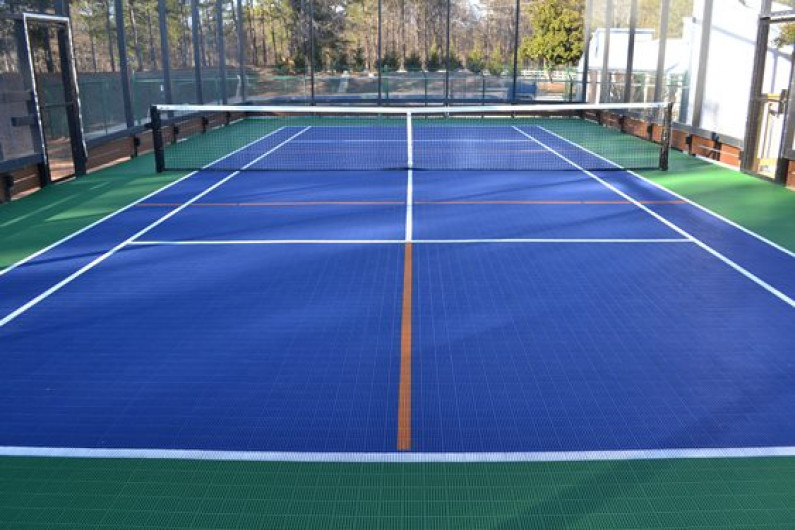Pickleball Court Construction-- Crucial Tips for a Long Lasting Court
Sustainable Practices in Pickleball Court Building And Construction You Ought To Know
As the appeal of pickleball proceeds to climb, so too does the need for sustainable methods in court building. This method not just addresses environmental worries but likewise boosts the long life and capability of the courts. From choosing green materials to implementing efficient water drainage and energy-saving illumination services, there are numerous methods to consider. The impact of these practices extends much past the court itself. Comprehending how each element adds to a much more sustainable future welcomes better expedition into the intricate equilibrium between entertainment growth and ecological stewardship.
Selecting Eco-Friendly Materials
Picking environment-friendly materials is a crucial action in the building of lasting pickleball courts. The selection of sustainable products not only minimizes environmental effect yet also improves the longevity and performance of the court. Secret products include recycled rubber for the surface area, which supplies superb sturdiness and shock absorption while diverting waste from land fills.
In addition, making use of locally sourced products reduces transport discharges and sustains local economies. Pickleball court construction. For example, utilizing native hardwoods for secure fencing and seats can give a lasting visual while ensuring resilience versus the components.
Including absorptive products for court foundations can further add to sustainability by permitting all-natural water drainage and minimizing drainage. These selections not only safeguard neighborhood environments however additionally promote healthier play environments.
Efficient Drainage Solutions
While the option of eco-friendly products is crucial, applying efficient water drainage services is just as vital for preserving lasting pickleball courts. Appropriate drainage not only secures the court surface from water damage but additionally reduces disintegration and runoff, promoting ecological stability.
Efficient water drainage systems can include permeable paving, which enables water to infiltrate the ground instead of merging on the surface. This reduces the probability of standing water, which can cause mold and other upkeep problems. Additionally, incorporating purposefully positioned water drainage networks and swales can guide excess water away from the court area, making certain a dry playing surface area and avoiding dirt erosion.
Using indigenous plants in the landscape design around the courts can better enhance water drainage by absorbing excess water and reducing drainage. These plants need much less irrigation and promote biodiversity, aligning with sustainable techniques.
In addition, it is crucial to routinely keep the drainage system to guarantee its long-lasting effectiveness. This includes clearing debris and surveillance for blockages. By focusing on efficient drainage options, pickleball court producers can substantially contribute to the sustainability and long life of the facility, eventually profiting both players and the atmosphere.
Energy-Efficient Lighting Options
As the demand for pickleball proceeds to expand, integrating energy-efficient lights options right into court design has actually ended up being significantly essential for sustainability. Traditional illumination systems typically consume too much energy, adding to greater functional prices and environmental impact. Embracing contemporary, energy-efficient innovations is essential for both brand-new constructions and improvements.
LED (Light Emitting Diode) illumination sticks out as a top selection as a result of its longevity and power savings (Pickleball court construction). Compared to traditional illumination, LEDs utilize around 75% much less energy and can last as much as 25 times longer, dramatically decreasing upkeep expenses. The directional nature of LED illumination minimizes light pollution, ensuring that lighting is concentrated on the court rather than bordering locations.

Sustainable Surface Alternatives
Discovering sustainable surface choices for pickleball courts has acquired traction amongst builders and players alike. The emphasis on eco-friendly materials not only straightens with the expanding environmental awareness but also improves the efficiency and longevity of the courts.
This product supplies excellent shock absorption, reducing the danger of injuries for gamers while advertising sustainability. These tiles are very easy to set up and change, and their convenience enables for various court arrangements.
Natural lawn courts are also becoming a sustainable option, advertising biodiversity and reducing the heat island impact. Nonetheless, they call for regular upkeep and water, which may not align with all sustainability goals.

Water Preservation Techniques

One more reliable method includes the installment of why not check here rain harvesting systems. These systems save and gather rain for use in keeping court surfaces and landscape design. This strategy not only preserves potable water however also minimizes dependence on community resources.
Furthermore, utilizing drought-resistant landscape design around the courts is necessary. Native plants need much less water and are much better adapted to regional environment problems, hence decreasing total water consumption. Furthermore, making use of reliable irrigation systems, such as drip irrigation, ensures that water is provided straight to plant origins, decreasing dissipation and waste.
Conclusion
Including lasting methods in pickleball court construction considerably contributes to environmental conservation and source effectiveness. By focusing on these techniques, the building and construction of pickleball courts can align with more comprehensive environmental goals while promoting long life and functionality within neighborhoods.
As the appeal of pickleball continues to increase, so also does the demand for sustainable methods in court construction.Selecting eco-friendly materials is an essential step in the building and construction of lasting pickleball courts. By focusing on energy-efficient lights options, pickleball court builders can contribute to a much more sustainable future while satisfying the requirements of stakeholders and Clicking Here players alike.Including lasting surface area alternatives not only improves the efficiency of pickleball courts but additionally paves the way for executing effective water preservation techniques.Integrating sustainable techniques in pickleball court construction significantly adds to ecological conservation and resource efficiency.